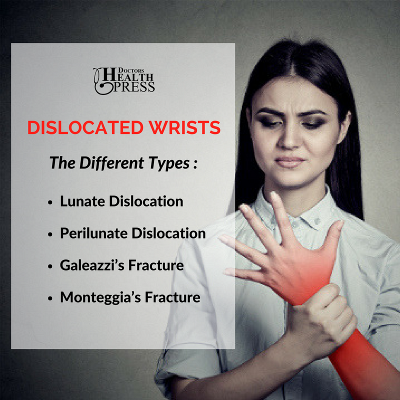
Credit: iStock.com/SIphotography
Wrist dislocation occurs when any of the 10 bones in the wrist become dislocated. A dislocated wrist is a pretty common condition, but do you know how to recognize a dislocated wrist? How do you know if your wrist is dislocated?
We will look at the different types of dislocated wrists and how to treat them with effective exercises.
By the time you are done reading this article, you’ll have enough information to know if you’ve dislocated your wrist and what you should do about it.
Dislocated Wrist (Wrist Dislocation) Types
You may think that a dislocated wrist is simply wrist dislocation. The truth is, there are a few different types of dislocated wrists.
1. Lunate Dislocation
This is the dislocation of the carpal bone known as the lunate. It’s located towards the center of the wrist. Specifically, it is in the center of the proximal row carpal bones (between the ulna and radius and the hand itself).
Lunate dislocation is also one of the most common types of wrist dislocation.
2. Perilunate Dislocation
Located near the lunate bone, dislocation of the capitate bone from the lunate bone is one of the most common types of wrist dislocation.
3. Galeazzi’s Fracture
This type of dislocation occurs along the ulna when there is a fracture of the radius.
4. Monteggia’s Fracture
A reverse of Galeazzi’s fracture, this is the dislocation of the radius when the ulna has been fractured.

What Causes a Dislocated Wrist?
Dislocated wrists, more often than not, are caused by trauma related to a sport or activity. But usually, a dislocated wrist occurs as a result of a fall where you arms stretch out in an attempt to break your fall.
Another common cause of a dislocated wrist is a previous injury. If you have broken a bone or seriously injured your wrist before, falling or suddenly bracing your self with your hand and wrist can cause a dislocation.
Signs and Symptoms of a Dislocated Wrist
There are several dislocated wrist symptoms that you will easily recognize. One of the things that you should keep in mind is that the wrist and hand are connected, so when you damage your wrist, it is not unusual for symptoms to appear in the hand as well. Dislocated wrist symptoms can include:
- Bruising and swelling
- Instant pain after injuring the wrist
- Exacerbating pain with movements
- Tenderness with palpations
- Diminished range of wrist motion
- A tingling sensation in the index and middle finger, as well as the thumb
- Thumb and finger stiffness
- Exacerbating pain with gripping
- A deformed wrist
Wrist Dislocation Diagnosis
When diagnosing a dislocated wrist, the doctor will first look at your medical history and will note not only recent physical incidents but also incidents from the past. After the medical history discussion, the doctor will make a physical examination of the wrist.
Depending on the physical diagnosis, the next step may be to have imaging tests. These may include an X-ray, MRI, or a CT scan to take a full look at that damage to the wrist area, and to check for any broken bones that may have occurred in addition to a dislocation.
Treating Wrist Dislocation
Wrist dislocation treatment depends on a few factors like the position of the bones, and if there is a break as well as a dislocation. If possible, the bones may be manually manipulated back into position.
It isn’t unusual for surgery to be required, especially if there is bone breakage or it’s necessary to realign wrist bones into their proper place. Soft tissue and ligament damage may also be repaired at the same time.
If surgery is required, the hand and wrist are often immobilized afterward to keep them in the right spot, as well as to avoid reinjury during the healing process. In this case, you will have to wear a hard cast on the hand and wrist for approximately six weeks.
Once the cast is off, the doctor will recommend rehab exercises to strengthen your wrist and bring it back to full functionality and movement.
Exercises for a Dislocated Wrist
When rehabilitating a wrist injury or dislocation, there are some exercises that you can do to build strength back in your wrist, as well to regain movement and flexibility in that area. Please note that all wrist injuries are not the same, and the following exercises are meant to be performed with the permission of your doctor.
If the exercise is creating pain beyond what a doctor expects, stop the exercise immediately.
1. Ball Squeeze
Using a ball that is firm but has some give to it like a tennis ball. Squeeze the ball as hard as you can and hold it for 10 seconds and then release. Repeat this exercise for 10 more repetitions.
2. Wrist Flexion
Hold a weight in your palm facing towards the ceiling. Slowly, bend the wrist upwards and then return it to normal. Proceed to repeat this motion for a total of 15 repetitions. After a few days, increase the weight.
3. Resistance Band Wrist Flexion
Place a resistance band over the fingers while your palm is facing towards the ceiling. Keep the elbow at the side of the body, bent at a right angle, supporting it with your other hand. Slowly, curl your wrist and fingers upwards (you should be able to feel the muscles in your forearms go tight). Repeat for 15 repetitions.
4. Wrist Extension
Hold a weight in the palm of your hand but this time, face the palm towards the floor. Bend the wrist upwards for 15 repetitions. Over time, you can increase the weight.
5. Resistance Band Wrist Extension
Place a resistance band over the fingers with the palm faced downwards. Keep the elbow at the side of the body, bent at the right angle and supported with the other hand. Slowly, curl the fingers and wrist upwards towards the ceiling (you should feel the muscles in your forearm go tight). Repeat for 15 repetitions.
6. Resistance Band Radial Deviation
Place a resistance band over your fingers with your thumb facing upwards while keeping your elbow at the side of your body, bent at a right angle with your other hand supporting it. Slowly, curl your wrist upwards with your forearm muscles becoming tight. Repeat for 15 repetitions.
7. Assisted Supinator Stretch
For this exercise, you will need a partner to help you out.
Lie down, keep your elbow on the ground while your hand is raised up, and extend your fingers to the ceiling. Your partner then fully pronates the hand so the palm faces down. You should feel a mild stretch in the wrist and forearm. Repeat this for five repetitions.
Keep Your Wrist Strong
Your wrist is has a lot of bones, 10 of them to be precise. Dislocating one or more of those bones isn’t as hard as one might think. That said, if you think you’ve dislocated a bone in your wrist, make sure to get it checked out and diagnosed.
Beyond the dislocation, there’s a good chance that you may have broken something and possibly done damage to the soft tissue and ligaments in that area. The faster it is checked out, the faster you can start with your road to recovery.
Also Read:
Sources:
“Wrist Dislocation: Types, Causes, Signs, Symptoms, Treatment, Exercises, Investigations,” ePain Assist, March 8, 2017; https://www.epainassist.com/sports-injuries/wrist-injuries/wrist-dislocation, last accessed August 8, 2017.
“Assisted Supinator Stretch,” Sports Injury Clinic; http://www.sportsinjuryclinic.net/rehabilitation-exercises/wrist-hand-finger-exercises/assisted-supinator-stretch, last accessed August 8, 2017.
“Dislocated Wrist,” Sports Injury Clinic, http://www.sportsinjuryclinic.net/sport-injuries/wrist-pain/dislocated-wrist, last accessed August 8, 2017.
“Dislocations of the Hand, Wrist, & Elbow,” Hinsdale Orthopedics, https://hinsdale-orthopaedics.com/specialties/dislocations-hand-wrist-elbow, last accessed August 8, 2017.
“Galeazzi Fracture,” Wikipedia, https://en.wikipedia.org/wiki/Galeazzi_fracture, last accessed August 8, 2017.
“Joint Dislocation,” Wikipedia, https://en.wikipedia.org/wiki/Joint_dislocation, last accessed August 8, 2017.
